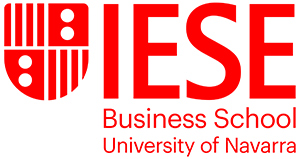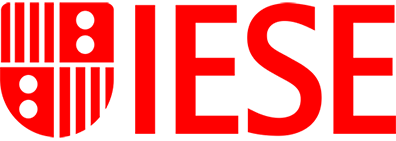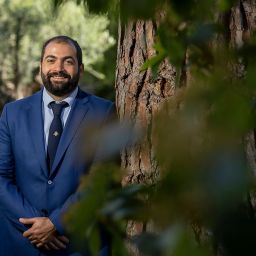In this special episode, we look back at some of the most human stories and the hardest truths from series one of This is Real Leadership.
From how you ask a co-founder to leave, to one reason Steve Jobs was so successful, we’ve been finding out what real leadership looks like today. And it’s all here – the wow-yeah and the heck-no.
Looking back across our previous seven episodes are two distinguished commentators. Sandra Sieber is Professor of Entrepreneurship at IESE Business School, one of the world’s best business schools. Sebastian Reiche is Professor of Managing People in Organisations at IESE Business School. IESE was ranked No.1 in the world for six years running by the Financial Times.
This is Real leadership podcast: Every episode, a business leader shares human stories and hard truths from their career. And an expert turns those stories into lessons we can all learn.
In this episode, Sandra and Sebastian discuss:
- How to fail right.
- Is leadership as easy as pie? Or Pi?
- How to tell better stories and build stronger business cultures
- What really is real leadership today?
Listen to this podcast:
Fore more content like this visit the Real Leadership website.
Podcast transcription:
Featuring quotes from:
- Ep.1: 3 mistakes that made me a better leader. With Elena Betés
- Ep.2: The narrative, the collaborative… And the ugly
- Ep.3: Culture clashes and difficult decisions
- Ep.4: How to bring your authentic self to work
- Ep.5: Leading with joy (not fear). Productive magic
- Ep.6: Trust and productivity in a happy workplace
- Ep.7: How to make change happen
Ibukun Awosika – Former Chair, First Bank of Nigeria. NED, Cadbury Plc. One of the original dragons on the African version of Dragon’s Den, author, fellow of the African Leadership Initiative and Aspen Global Leadership Network, and Forbes “Chairperson of the Year” award winner 2020.
Geoffrey Moore – Advisor to the leaders of established high-tech enterprises. Most recently: Salesforce, Microsoft, and Google. And the author of several best-selling and hugely influential business books. Most notably: Crossing The Chasm.
Elena Betés Novoa – Founder and CEO (2008-15) and Chair (2015-22), Rastreator. CEO, dide.org. Serial entrepreneur. Winner of the International Women’s Entrepreneurial Challenge award in 2022. Forbes “Top 100 Most Creative”.
JJ Van Oosten – A serial digital transformationist, JJ has lead five large, complex and successful digital and omnichannel transformations at Rewe Group, Tesco, Travis Perkins, LEGO and Kingfisher.
Christina Janzer – Head of Research and Analytics, Slack. Armed with insights from Slack’s global knowledge worker research – a survey of 10,000 desk workers – Christina says she wants to make work a little better every day.
Arjen Schouten – Co-founder and Former COO cosmetics retailer Rituals, Arjen helped Rituals grow from zero to over 10,000 employees, 1000 stores and $1 billion in turnover.
Florian Weiss – Former CEO, Jameda, one of the largest providers of software for the healthcare industry.
Adam Burns:
Hello, and welcome to This is Real Leadership. Where, every episode, a proven business leader shares human stories and hard truths from across their career. And an expert turns those words into lessons we can all learn.
Well, at least, that’s what normally happens. But not in this episode. This episode, we’re looking back at some of the most human stories and the hardest truths from our previous seven pods. And I’m joined by not one, but two experts. Two distinguished professors from IESE, one of the world’s best business schools.
Professor of Entrepreneurship, Professor Sandra Sieber…
Professor Sandra Sieber
Hello Adam. It’s a pleasure to be here.
Adam Burns:
And Professor of Managing People in Organizations, Professor Sebastian Reiche…
Professor Sebastian Reiche
Hi Adam. It’s very good to talk to you again.
Adam Burns:
Lovely to see you both. And I’m very much looking forward to this. Now, we’ve picked ten quotes from across the series, covering everything from mistakes, to storytelling, to magic. So, let’s get on with it. Let’s find out what you have learned.
From Ep 1 – Growing from mistakes
Elena Betés Novoa
Former SVP of Education, Red Ventures. Founder and CEO (2008-15) and Chair (2015-22), Rastreator. Current CEO, dide.org (2023-).
Quote
I always say that, even when you’re failing, you have to fail right. Okay? And failing right means caring about employees, caring about clients, caring about what you are doing.
Adam Burns
That was Elena Betés Novoa, Founder, CEO and former Chair at Rastreator, and now CEO at dide.org. And that was from episode one, which talked about growing from mistakes. I think this is a fascinating phrase, “you have to fail right”. What does it mean to you?
Professor Sebastian Reiche
Don’t throw away the learning. That’s what Bill Gates always said. You can make mistakes, but just don’t throw away the learning. So, I think what we mean when we say “failing right” is that, first of all, we need to have the right context. One in which people can make mistakes. And then we need to grow from our mistakes; we get it right or do it better the next time around.
Professor Sandra Sieber
I tend to agree with Sebastian here. For me, there’s also the very important issue of understanding what the context is, and what the conditions to fail are. We talk about creating a learning culture, and the possibility to make mistakes, but we only do that under certain conditions. Meaning, when uncertainty is high, when ambiguity is there, when the complexity conditions are there, because that’s when we really need to learn. And sometimes we know things already, and then, failing is simply not okay. We know things, and we have to apply them correctly. And then we get into more of a productivity culture. Right? So, we can’t just say, now we are allowed to fail, and we are allowed to learn, because it’s not true. It’s true under certain conditions. I think we should always remember that, when we want to fail right, it’s really under those conditions where failure is appropriate, because it’s a way to learn.
Adam Burns
On the pod, Elena was talking with IESE’s Professor Iñigo Gallo. He asked, “do we sometimes put too much emphasis on the benefits of making mistakes?” What do you think?
Professor Sebastian Reiche
I remember, for a long time, surgeons really struggled to share mistakes. Because, obviously, if you make a mistake during surgery, the person has to be wheeled back… So, it’s a high stakes environment. You make yourself liable, and yet, if you know what went wrong, you don’t want your colleague to make the same mistake. And so, they started doing this behind locked doors. Nobody else would see it, but the people who could learn from it were in the same room. So, it’s not celebrating mistakes, but, again, coming back to this point, it’s creating the conditions where everyone who can learn from them is there. You’re making yourself securely vulnerable. It’s not fully public. Maybe not everyone sees the mistake, but we’re sharing what needs to be shared so that it doesn’t happen again.
Adam Burns
So, failing right is about making sure you don’t throw away the learning, but it’s not about accepting failure everywhere. Only in situations where there’s ambiguity or complexity, or where we face the unknown. If the learning already exists, well, learn it. And if sharing failures makes you uncomfortable, do as the surgeons did. Find a locked room, and make yourself securely vulnerable.
Our experts are agreed, then. There are times when it’s useful to let people make mistakes. What’s interesting is some of the small nuances that emerged when I asked, “who makes that decision?” Here’s Arjen Schouten, Former COO and Co-Owner at Rituals, from episode three…
From Ep 3 – How to make tough decisions
Arjen Schouten
Co-Chair, ShareAndWonder Foundation. Former COO and Co-Owner, Rituals.
Quote
I think that you need to let your teams come up with their own solutions, and give them the freedom to be brave and implement their ideas, and let them make their own mistakes, as you have made your own mistakes. And that is the hardest thing, because you’re very tempted to say “No, that doesn’t work”. But, don’t be afraid. Let them be vulnerable, and don’t punish them too early for the mistakes they might make. There’s only one thing, one golden rule, which is to not make the same mistake over and over again. Then, you might have an issue.
Adam Burns
Sebastian, as a leader, is it your job to decide when people can make their own mistakes?
Professor Sebastian Reiche
There’s this assumption that, as a leader, you decide whether to let people make a mistake, or solve it yourself. Or rather, the temptation is to solve it. But there are many contexts in which you might actually have someone further down the hierarchy who knows better; who has the expertise, the local influence or the network, or who is better positioned. So, I think the question is also, “at what point can I find the right person?” Earlier, you asked if there are there too many benefits, or if we talk about the benefits of making mistakes too much. Maybe you can avoid the mistake if you find the right person. And maybe that means digging a bit deeper to find where that person is, rather than assuming that, by virtue of your hierarchical position, you should be able to do it. And then, it’s a decision of whether you let people make the mistake or not.
Adam Burns
And, are businesses good at teaching mistakes?
Professor Sandra Sieber
I think they’re better at commanding, rather than teaching. And in a fast-changing environment, what we probably have to do is teach people more. The relevant thing in teaching is actually the learning portion, and that comes after the mistake. So, my role as a manager, as a leader, is then to sit down with my team, or with my people, and do a post-mortem. And say, “Okay, let’s see what happened here. Why did we actually get this wrong?” So, we can allow people to do crazy things, but if we don’t then do a post-mortem afterwards, what are we doing it for?
Adam Burns
And maybe that’s the conundrum at heart of the modern “failure is fine” approach to business. Failure is fine, if you learn from it. But effective learning requires effective teaching, and for many businesses that is not a core competency. Which may help explain why, for a lot of organizations, talking about failure is still seen as a mistake.
That said, of course, mistakes do happen. And when they do, Elena has three super-simple approaches to dealing with them…
From Ep 1 – Growing from mistakes
Elena Betés Novoa
Former SVP of Education, Red Ventures. Founder and CEO (2008-15) and Chair (2015-22), Rastreator. Current CEO, dide.org (2023-).
Quote
If something goes wrong, you know, and everybody’s there, you say, “No problem. Great. This is an opportunity.” If you are in a one-to-one with somebody, and something has gone wrong, you go deeper and say, “Okay, what could you have done better? And what could I have done better to make sure that this doesn’t happen?” But if you are communicating to your board, then the mistake is yours.
Adam Burns
Sandra, I love the simplicity of this explanation. How you deal with mistakes is contextual. What is the most important thing you have learned, and that you teach, about mistakes?
Professor Sandra Sieber
For me, the most important thing about mistakes is, actually, to see that they’re just a small part in a big scheme for moving forward. It’s very hard to make a mistake in strategy, but it’s very easy to make a mistake in hypothesis formulation. Because when we form a hypothesis, we just go and validate it. And we know there’s a counter hypothesis. One of the two is going to be more okay. And when you get into this process, rather than truth or failure, you have a more iterative culture, going step-by-step, and understanding that we cannot do so without making mistakes. And then, we work on it together and just share. We make sure that we all understand where the mistake happened, why it happened, and what we will do differently the next time. When you start to get that right, I think it’s a very powerful learning tool.
Adam Burns
Two more highlights now. The first from Arjen, who joined us in episode three to talk about making tough decisions. And the second from JJ Van Oosten, CDO, CDTO, CEO, non-executive director and serial transformationist, who spoke about leading through change. Perhaps unsurprisingly, they had something in common. Good leadership, they said, is about two things: clarity and simplicity…
From Ep 3 – How to make tough decisions
Arjen Schouten
Co-Chair, ShareAndWonder Foundation. Former COO & Co-Owner, Rituals.
Quote
In the end, when you are in business, and when you are a leader, the teams that you’re working with ask for clarity and direction. And anything that gets in the way of this makes it harder for them to operate. Especially when they are sensing that there are different signals from the leadership team.
From Ep 7 – Leading through change
JJ Van Oosten
CDO, CDTO, CEO, NED
Quote
What is crucial and essential is to, very quickly, and in a very simplistic way, articulate the expected outcomes, in terms of the what and the how. And the bias for action comes in there, because you need to do that very quickly. And the skill that I have, really, in myself, mentally, and I have to remain true to it, is to keep that simplicity around the expected outcomes, in terms of the what and how. And to ensure that the complexity of the organization and the environment doesn’t dilute the simplicity that we just aligned ourselves against. When you have that simplicity, then you have a story. And when I have a story, it needs to be tailored to the culture of the company, the history of the company, and it needs to be simple enough that anyone working in a shop, or any of our customers walking to any of our shops, or anyone in a call center, or on a chat online for e-commerce, can understand it within seconds. And that’s hard.
Adam Burns
This seems so simple. Ultimately, teams just want clarity and direction. Is it true?
Professor Sebastian Reiche
I think it’s simple in the sense of being concise and consistent. Because, when you say there’s a need for clarity and simplicity, it’s about having a very clear direction, I think. Having a clear purpose, a mission, and a very clear strategy for, “where are we heading?” Knowing exactly what your core values are, either as an organization or as an individual, makes life easier, because it’s easier for you to prioritize, to say no, or to take that one opportunity. You’re bombarded with different opportunities, and you’re able to navigate through them and decide which opportunity you’re going to pursue. So, that’s simple, in a way, because you have a clearer direction.
Adam Burns
And Sandra, JJ talked about ensuring that “the complexity of the organization and the environment” doesn’t dilute the simplicity of the story you tell your people and your customers. How can that be achieved?
Professor Sandra Sieber
When we talk about simplicity in times of change, the first thing that comes to mind is that we need autonomy, obviously. You cannot centralize, and you cannot plan for other things, because we are in times of change. So, the first thing that you’re asking for is autonomy. But then, we want this clarity and direction. And what happens is that we need mechanisms of alignment. The clarity and direction actually comes because we have a system of alignment. So, what we are talking about when we say “the complexity of the organization and the environment” is, how do we get organization within the environment? And how do we act on the things that happen outside, within a system that everybody understands, so that we can realign objectives and actually allow teams to be highly autonomous, but highly aligned? And then, suddenly, the whole thing gets simple again.
Adam Burns
We’ll revisit the idea of leadership being about keeping things simple later in the pod. But, for now, another key skill. And one of the best in the business joined us in episode two to talk about it. Geoffrey Moore is a best-selling author, keynote speaker – he says he’s never met a microphone he didn’t like – and advisor to companies, both small and very large indeed, including Microsoft and Salesforce. He wanted to talk about the power of storytelling…
SECTION 3: STORYTELLING, COMMUNICATION AND CULTURE
From Ep 2 – The power of storytelling
Geoffrey Moore
Author, Speaker, Advisor.
Quote
Narrative is at the core of identity, the core of mission and the core of purpose. Because narratives inspire people. And for me… You see, the analytics, the spreadsheets, the Excels and the SAP financial statements, they’re a necessary part of making it work. But they do not inspire. They do not engage and they don’t enlist. But when Steve Jobs said, “We want to think different here. We want to change the world. We don’t want to make sugar water. We want to make computers,” that engages and enlists. Like the narratives that are coming out of the Ukraine right now. I mean, Zelensky, he has an amazing capability to tell a narrative. And it’s just leadership. I think, to me, that’s why I care so much about narratives.
Adam Burns
Sebastian, business needs analytics and financials, and all that stuff needs management. But I think narrative, or storytelling, is a leadership skill, not a management skill. Do you agree?
Professor Sebastian Reiche
Yes, I do agree. I think, as a leader, your role is to inspire and to motivate. And telling stories, or crafting a narrative, ultimately, is a tool to create more simplicity in a complex environment. In a large organization, you need everyone to tell similar stories so that the key areas, the key values, and the key messages get through. And so, to me, that’s a key leadership skill.
Professor Sandra Sieber
Here, what we see is that narrative is especially important when the product is very complex, or the environment is changing very quickly. And we see that people need narrative, especially in fast moving industries. Both internally and externally. So, very often, you even need a narrative to engage with your customers, so that the customers realize which products they actually want to buy, and how to use the product. For example, when you saw the first iPod come on the market, people actually didn’t know what it was for. So, either you have a good narrative, or you cannot even sell your products. Now, the good leader, and not just business leaders, but also society leaders, actually needs to help us understand the world we are building, because it’s changing so incredibly fast.
Adam Burns
So, now we’re starting to pull together a narrative of our own from across the seven podcasts. Real leadership is about accepting mistakes in certain situations, such as when there are high levels of ambiguity and complexity, and always learning from those mistakes. It’s about providing complex organizations with real clarity of purpose and direction. And it’s about inspired storytelling.
But what happens in the everyday, when the leader is not there. How do you build a self-sustaining culture? Ibukun Awosika is an entrepreneur and a challenger. She joined us in episode four to talk about being authentic, and staying true to you. And this is what she had to say about building businesses with value, and values.
From Ep 4 – Being authentic
Ibukun Awosika
Entrepreneur, leader, speaker, challenger
Quote
I think communication is a majorly powerful tool. Communication, and example setting. Because, you know, words are cheap. Anybody can say anything. But action is tougher. And if you communicate very clearly what those expectations are, if you communicate very clearly what your vision is, if you communicate very clearly what your values are, and you document this as much as is possible, but more than that, you build those things that you say that you are into the DNA of the practices and the processes within the organization… Because, the leader, or the founder, will not be the one that is seen every day. But, if you’ve built it as a culture, and as the DNA, and the leaders you choose along the pipeline, to a large extent, represent the culture… That’s how corporate cultures are built, in a sense. There is good culture, bad culture. But how do you maintain it? It’s in continuous renewal, never taken for granted. Being consistently deliberate in choosing leaders at every level, not just leaders at the top, who represent what you consider to be important within your organization. I think, this way, over time, you would find that you’re able to consistently move the values forward through the generations.
Adam Burns
Sebastian, I really liked this quote from Ibukun. We get a sense of the complexity inherent in leadership and culture building. We talk a lot, even in this podcast, of course, about keeping things simple. But there’s nuance and compromise, and complexity and process. And when Ibukun talks of building a culture of continuous renewal, it made me think of a conversation you and I had with Arjen, in his episode, about hiring. Is hiring one of the areas that is most commonly and easily overlooked by the busy business leader?
Professor Sebastian Reiche
I fully agree. It’s your golden opportunity. Hiring is your golden opportunity to get people in who share the same purpose, and the same values. You can move people between roles, and you can develop skills. But having a value misalignment is much more difficult. You can obviously brainwash people later on, but it takes much longer. So, getting the right people in makes your life easy, because you don’t have to performance manage them later on. But I agree, it’s overlooked. And, in fact, if I think back to how many programs we’ve run on strategic hiring, I can’t think of very many. So, unfortunately, there is also not that much demand for organizations to really drill down into what it means to hire recruits strategically. And yet, I fully agree that it’s an important part of the way you build culture. You become who you recruit. Especially at higher levels, when you make high senior appointments. Whoever joins your organization will shape the future of your organization. They will shape your culture, and your strategy. So being very careful in your hiring is key.
Adam Burns
You become what you hire. That is a fabulous phrase.
We’re coming to the end of our series wrap now, and we shift our focus to people. Specifically, to getting the best from them. Here are Dr. Florian Weiß, former CEO of Jameda, and Christina Janzer, Head of Research and Analytics with Slack…
From Ep 5 – Optimism and productive magic
Dr. Florian Weiß
Former CEO, Jameda
Quote
Even if you don’t change the world every day, you do change the world of the people you work with.
From Ep 6 – Building brilliant places to work
Christina Janzer
Head of Research and Analytics, Slack
Quote
So, as you can imagine, work has changed dramatically over the last few years. We first saw, with the pandemic, people changing where and when they work. And what we’re seeing now is that there’s a huge focus on productivity. What we’re seeing is that executives are really stressed about squeezing more productivity out of their teams. I think, for something like 70% of executives, their number one concern is, “How do we get our employees to be more productive?” But what’s really interesting is that they’re thinking about productivity in, what I would consider, a very backwards way. They’re really focused on tracking what we call activity metrics. So, how many hours a day are people working? How many emails are they sending? Things like that. And what that’s doing is causing employees to focus on performative work. How can I appear productive? How can I make sure that I’m doing things that prove to my boss that I’m working? And the thing is, that doesn’t actually make people more productive. So, we’re focused on the wrong things. And I think there’s a huge opportunity for executives to shift their thinking. Meaning, let’s not focus on the number of hours that people are working. Let’s not focus on emails. Let’s track outputs. Let’s not track inputs. Let’s really get to the bottom of what we can do to improve productivity. And what we found to be the number one driver of productivity is trust. So, there’s a big opportunity for us to really think about, “How can we rebuild a culture of trust in the workplace?” Because that’s what’s going to ultimately drive productivity.
Adam Burns
Sandra, this sounds a lot like we’re making the same mistakes again. Presenteeism is one of the least effective in-person measures of productivity. And now we’re measuring it online as well. Why? Christina says 70% of executives want more productivity. Why are they putting measures in place that cause employees to focus on performative work?
Professor Sandra Sieber
I think it’s very important to see that, often, when we talk about digital transformation, we’re actually just referring to digital adaptation. And then, it’s more like business as usual. So, if you’re very productivity-focused, what you do is you put KPIs of productivity in place. This is because you’re not transforming. You’re just doing an adaptation that you hadn’t done before. And the COVID crisis actually triggered a lot of this. When it’s really about transformation, then it’s an adaptation to uncertain environments, to complex environments, or to something that you don’t know. And that is, I think, when the trust thing comes in. Because then, you need to give the teams slack. You need to give them the space to explore, to find out, to build new things, to make mistakes, and to learn from them. And then, you will define productivity in a very different way, because it’s going to be a learning outcome, not an earning outcome. And your KPIs are going to be different. They’re not going to be based on productivity. They’re going to be based on transformation. They’re going to be based on really innovating beyond the current limits.
Professor Sebastian Reiche
You asked, why do managers do that? Why are we going back to these metrics? If you think about control, there are three different types of control. There’s social control: people checking on each other, and peers checking on each other. There’s process control: I’m checking that you’re following a process that we’ve established. And there’s output control. Now, it so happens that managers still prefer process control, despite the pandemic, where we’ve been forced to sit back and give more autonomy to our teams. This is not new. We’re discussing this now, and we’ve been discussing it for many decades. These different control mechanisms have been around for 50, 60, 70 years, and yet, we’re still struggling with our temptation to move back to process control. Sandra mentioned command, control, just double-checking… And we really need to move away from this. It’s difficult, but we really need to move away from this.
From Ep 5 – Optimism and productive magic
Dr. Florian Weiß
Former CEO, Jameda
Quote
If you imagine for yourself a kind of graph, with an x-axis and a y-axis. On the x-axis, you would have the amount of knowledge about the company, about your competition, about the market. And you start with zero, and you go very far to the right, and you have 100% knowledge. On the y-axis, you have the amount of amazement and wonder in your company. Then, of course, if you have zero knowledge, everybody’s just amazed. Everything is a miracle, because you cannot explain anything; you don’t want your company to be in that place. But, let me talk about the other extreme. You know, where everything can be calculated based on algorithms. Everything is set into KPIs. At that moment, you have zero amazement, zero wonder, zero awe, and, I think, zero identification. At that moment, nobody loves to work in your company, because it’s nothing special. There’s no secret, no magic. So, I gave this kind of zone a name, which I call productive magic. Where you do leave some room for the magic to happen. Not everything is explainable. Not everything will be clear to everybody, but it does inspire people.
Adam Burns
Christina talked about rebuilding a culture of trust in the workplace. Florian talked then, I think, about something similar. About not measuring everything. About letting people play a little, and be experimental. But, Florian did say, of his productive magic idea, that “not everything will be clear to everybody”. And elsewhere, we’ve heard about the importance of clarity. Arjen said that teams ask for clarity and they ask for direction, and anything that gets in between makes it harder for them to operate. Is this balance between knowing what to measure, and when to let your people play, a critical modern skill? Is that something about which we can say: this is real leadership today?
Professor Sandra Sieber
In the end, real leadership today is a balancing act. Right? It’s understanding the different conditions that I have for different types of problems, and then applying different rules, or different tool sets, in order to be able to solve them.
Professor Sebastian Reiche
And I think managing dualities, in general, is what leadership is about. It’s not just about technology, when to use technology or when not to use it, and when to explore or when to exploit. Think about empowerment, for example. As a parent, you want to empower your kids. 100%. It’s difficult, but ultimately it’s easy, because you know where you’re heading. In an organization, it’s not 100%. So, the duality is, when do you empower, and when do you not empower. Again, it’s managing these two dualities. And, as someone mentioned, in many contexts, you, as a leader, have to undertake the balancing act of giving autonomy, making sure that team is accountable, aligning and realigning. So, it’s those balancing acts that leaders engage in. I think I would very much agree with that.
Adam
Sandra, Sebastian, thank you very much indeed.
Professor Sandra Sieber
It has been a pleasure.
Professor Sebastian Reiche
My pleasure, too.
Adam Burns
Well, thank you to Professor Sandra Sieber, Professor of Entrepreneurship, and Professor Sebastian Reiche, Professor of Managing People in Organizations, both at IESE Business School. And thank you for listening. All the episodes we’ve talked about are available now, I guess, wherever you found this one. Please do subscribe, share and let us know what you think. Is there anything you’d like us to talk about? Our contact details are in the podcast description. But for now, I’m Adam Burns. Goodbye.

















